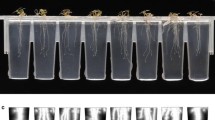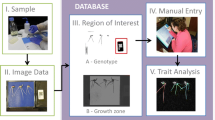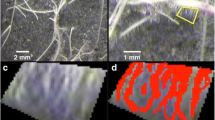Abstract
Background and aims
RootScan is a program for semi-automated image analysis of anatomical traits in root cross-sections.
Methods
RootScan uses pixel thresholds to separate the cross-section from its background and to divide it into tissue regions. Area measurements and object counts are performed within various regions of interest. A graphical user interface permits the user to see which regions are selected, to edit those selections, and to rate and comment on the data. The structure of the program allows for organized workflow and increased data collection efficiency.
Results
The program collects data on more than 20 variables per image including areas of the cross-section, stele, cortex, aerenchyma lacunae, xylem vessels, and counts of cortical cells and cell files. An increased rate of data collection allows collection of four times more variables in less time than is possible with current methods. Correlation analysis shows that RootScan data is equal or greater in accuracy than data collected with Photoshop.
Conclusions
Compared with currently available tools, this software offers considerable improvements in the amount and quality of data, ease of use, and time needed for data collection. RootScan permits phenotypic scoring of physiologically and agronomically important traits on a large number of genotypes.





Similar content being viewed by others
Abbreviations
- GUI:
-
(graphical user interface)
- RCA:
-
(root cortical aerenchyma)
References
Drew M, Fourcy A (1986) Radial movement of cations across aerenchymatous roots of Zea mays measured by electron probe X-Ray microanalysis. J Exp Bot 37:823–831
Drew MC, Saker LR (1986) Ion transport to the xylem in aerenchymatous roots of Zea mays L. J Exp Bot 37:22–33
Fan MS, Zhu JM, Richards C, Brown KM, Lynch JP (2003) Physiological roles for aerenchyma in phosphorus-stressed roots. Funct Plant Biol 30:493–506
Fan MS, Bai RQ, Zhao XF, Zhang JH (2007) Aerenchyma formed under phosphorus deficiency contributes to the reduced root hydraulic conductivity in maize roots. J Int Plant Biol 49:598–604
Fester T, Hause G (2005) Accumulation of reactive oxygen species in arbuscular mycorrhizal roots. Mycorrhiza 15:373–379
Gonzalez RC, Woods RE (1992) Digital image processing. Addison-Wesley, Reading, MA
Gregory PJ, Bengough AG, Grinev D, Schmidt S, Thomas WTB, Wojciechowski T, Young IM (2009) Root phenomics of crops: opportunities and challenges. Func Plant Biol 36:922–929
Haining RP (2003) Spatial data analysis: theory and practice. Cambridge University Press.
Justin S, Armstrong W (1987) The anatomical characteristics of roots and plant response to soil flooding. New Phytol 106:465–495
Longstreth DJ, Borkhsenious ON (2000) Root cell ultrastructure in developing aerenchyma tissue of three wetland species. Ann Bot 86:641–646
Lynch JP, Ho MD (2005) Rhizoeconomics: carbon costs of phosphorus acquisition. Plant Soil 269:45–56
Otsu N (1979) Threshold selection method from gray-level histograms. IEEE Trans Syst Man Cybern 9:62–66
Postma JA, Lynch JP (2011a) Root cortical aerenchyma enhances growth of Zea mays L. on soils with suboptimal availability of nitrogen, phosphorus and potassium. Plant Physiol 156:1190–1201. doi:10.1104/pp.111.175489
Postma JA, Lynch JP (2011b) Theoretical evidence for the functional benefit of root cortical aerenchyma in soils with low phosphorus availability. Ann Bot 107:829–841
R Development Core Team (2010) R: A language and environment for statistical computing. R Foundation for Statistical Computing, Vienna, Austria. ISBN 3-900051-07-0, URL http://www.R-project.org.
Richards RA, Passioura JB (1989) A breeding program to reduce the diameter of the major xylem vessel in the seminal roots of wheat and its effect on grain yield in rain-fed environments. Aust J Agr Res 40:943–950
Tombesi S, Johnson RS, Day KR, DeJong TM (2010) Relationships between xylem vessel characteristics, calculated axial hydraulic conductance and size-controlling capacity of peach rootstocks. Ann Bot 105:327–331
Wright SR, Jennette MW, Coble HD, Rufty TW (1999) Root morphology of young Glycine max, Senna obtusifolia, and Amaranthus palmeri. Weed Sci 47:706–711
Zhu J, Brown KM, Lynch JP (2010) Root cortical aerenchyma improves the drought tolerance of maize (Zea mays L.). Plant Cell Environ 33:740–749
Zobel RW (2003) Sensitivity analysis of computer-based diameter measurement from digital images. Crop Sci 43:583–5
Acknowledgements
We thank Lauren Gelesh, Johanna Mirenda, Gina Riggio, Andy Evensen, Robert Snyder, and Chinmay Rao for technical assistance. United States Department of Agriculture, National Research Initiative provided funding for this research via grant 207-35100-18365 to JPL and KMB
Author information
Authors and Affiliations
Corresponding author
Additional information
Responsible Editor: Matthias Wissuwa.
Electronic supplementary material
Below is the link to the electronic supplementary material.
Online resource 1
RootScan screenshots before and after lateral root selection in Zea mays. The user outlines the lateral root segment (a) and it is removed (b). (JPEG 114 kb)
Online resource 2
Example of erroneous automatic cross-section selection. RootScan selected root hairs as part of this rice (Oryza sativa) root cross-section (red line). The user removed them by drawing a polygon that excluded the incorrect areas (blue line). Note that it is not necessary to draw the outline exactly, since the original selection will be used when it is inside the polygon. (JPEG 134 kb)
Online resource 3
Rice root section images during aerenchyma selection and correction. The left image (a) shows that the program missed some aerenchyma lacunae, so the user manually selected the omitted objects by clicking with a crosshair tool. The right image (b) shows the aerenchyma lacunae in red after both RootScan and manual selection. (JPEG 215 kb)
Online resource 4
RootScan incorrectly included part of the cortex of this field-grown maize root during the stele selection step (green line). The user redraws the stele boundary with a polygon tool (blue line). The error was caused by the high-contrast areas in the inner cortex due to fungal infection. (JPEG 124 kb)
Online resource 5
The left image (a) shows a maize root section that has been sheared during sectioning. The cells and lacunae on the upper left are blurred. As a result, the lacunae in that region (image b, in red) are no longer completely visible and the area is reduced. The cells in that area are pixelated and cell counts would be too high. (JPEG 162 kb)
Rights and permissions
About this article
Cite this article
Burton, A.L., Williams, M., Lynch, J.P. et al. RootScan: Software for high-throughput analysis of root anatomical traits. Plant Soil 357, 189–203 (2012). https://doi.org/10.1007/s11104-012-1138-2
Received:
Accepted:
Published:
Issue Date:
DOI: https://doi.org/10.1007/s11104-012-1138-2




